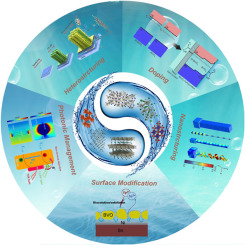Nano Energy ( IF 17.6 ) Pub Date : 2018-06-22 , DOI: 10.1016/j.nanoen.2018.06.074 Jie Jian , Guangshen Jiang , Roel van de Krol , Bingqing Wei , Hongqiang Wang

|
Rational engineering of photoelectrode materials that are highly efficient, stable, and simple in fabrication is of importance for developing a viable photoelectrochemical (PEC) water splitting device. The recent years have seen the surge in the development of multinary semiconductor materials for promising solar hydrogen generation, owing, in part, to the limitations of binary oxides, namely, TiO2, WO3, and Fe2O3. With three or more different atomic constituents the number of material candidates far exceeds that of binary oxides, thereby increasing the opportunity to find candidates with suitable band structures, stabilities, and carrier lifetimes, which promises a higher solar to hydrogen conversion efficiency. However, further engineering of these promising semiconductors is imperative to overcome their remaining limitations for viable PEC water splitting. In this review, we survey the most recent developments in the engineering of multinary semiconductors for improved PEC performance, in which we mainly discuss the progress on semiconductor-liquid junctions rather than photovoltaic-electrolysis. We first present their fundamental advances and disturbing aspects for PEC applications of the representative promising multinary semiconductors including metal oxides, metal oxynitrides, copper chalcogenides, phosphides and nitrides. Then we analyze five common engineering protocols that have been effectively adopted for the improved PEC performance, including nanostructuring, doping, surface modification, heterostructuring, and photonic management. The progress on assembling them in PEC tandem devices is also discussed. We present finally an outlook on the future efforts as well as the challenges that have to be tackled in the way of pursuing viable PEC multinary semiconductors.
中文翻译:

用于光电化学制氢的多元半导体合理工程的最新进展
高效,稳定和易于制造的光电极材料的合理工程设计对于开发可行的光电化学(PEC)水分解装置至关重要。近年来,用于产生有希望的太阳能氢的多元半导体材料的开发激增,部分原因是由于二元氧化物(即TiO 2,WO 3和Fe 2 O 3)的局限性。具有三种或三种以上不同的原子组成,候选材料的数量远远超过二元氧化物,从而增加了寻找具有合适能带结构,稳定性和载流子寿命的候选材料的机会,这有望提高太阳能到氢的转化效率。但是,必须对这些有前途的半导体进行进一步的工程设计,以克服它们对于可行的PEC水分解的剩余限制。在这篇综述中,我们调查了多元半导体工程技术的最新进展,以提高PEC性能,其中我们主要讨论半导体-液体结而不是光伏电解的进展。我们首先介绍它们在具有代表性的有前景的多元半导体(包括金属氧化物,金属氧氮化物,硫属铜化物,磷化物和氮化物)的PEC应用中的基本进展和令人不安的方面。然后,我们分析了五个有效改善PEC性能的有效通用工程协议,包括纳米结构,掺杂,表面改性,异质结构和光子管理。还讨论了在PEC串联设备中组装它们的进展。我们最终提出了对未来努力的展望,以及在寻求可行的PEC多元半导体的过程中必须解决的挑战。然后,我们分析了五个有效改善PEC性能的有效通用工程协议,包括纳米结构,掺杂,表面改性,异质结构和光子管理。还讨论了在PEC串联设备中组装它们的进展。我们最终提出了对未来努力的展望,以及在寻求可行的PEC多元半导体的过程中必须解决的挑战。然后,我们分析了五个有效改善PEC性能的通用工程协议,包括纳米结构,掺杂,表面改性,异质结构和光子管理。还讨论了在PEC串联设备中组装它们的进展。我们最终提出了对未来努力的展望,以及在寻求可行的PEC多元半导体的过程中必须解决的挑战。



























 京公网安备 11010802027423号
京公网安备 11010802027423号